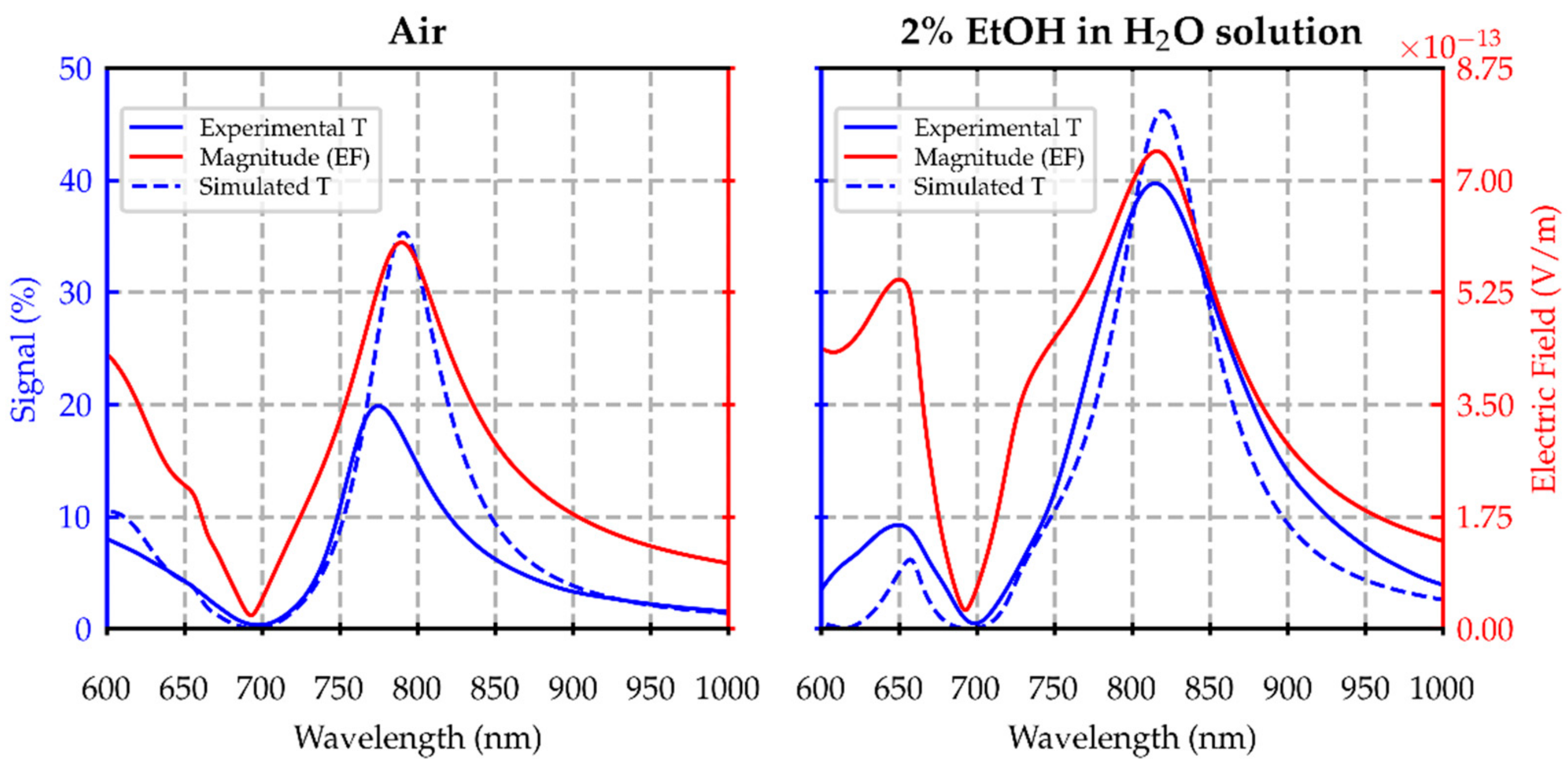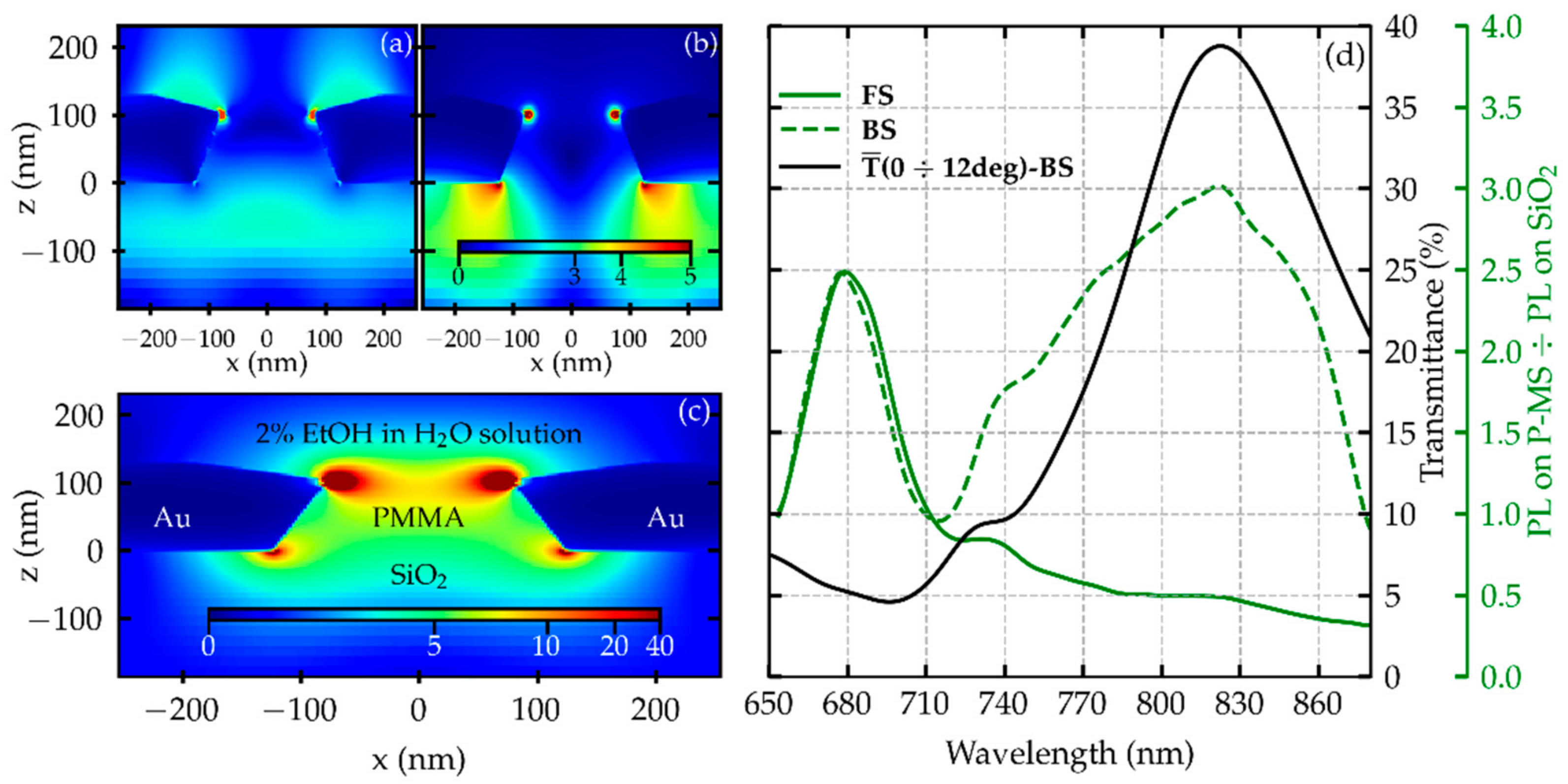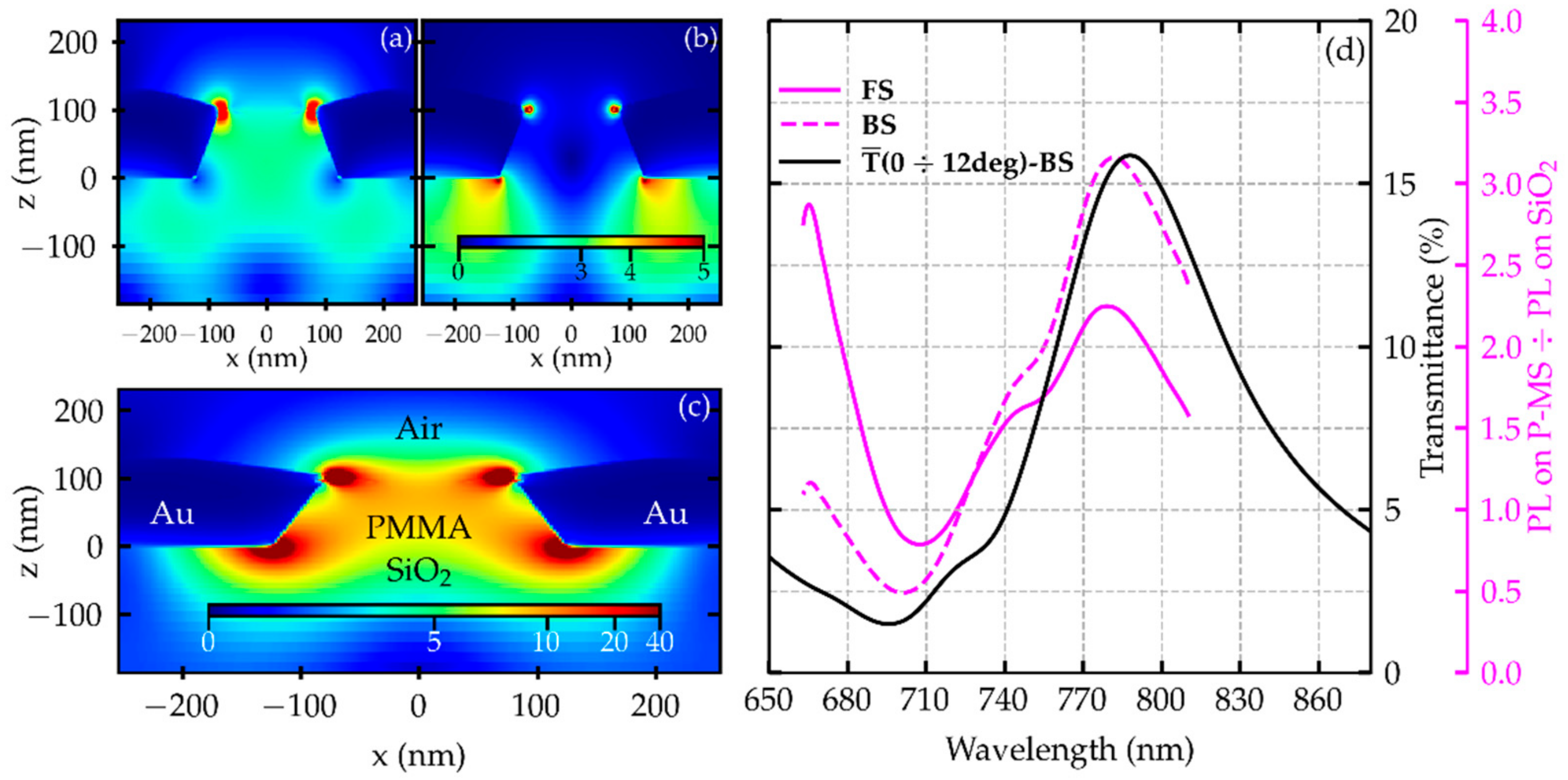Fluorescence Enhancement Dependence on Refractive Index Variation in a Nanostructured Plasmonic Surface †
Abstract
:1. Introduction
2. Materials and Methods
3. Results and Discussion
4. Conclusions
Author Contributions
Funding
Institutional Review Board Statement
Informed Consent Statement
Data Availability Statement
Conflicts of Interest
References
- Fort, E.; Grésillon, S. Surface enhanced fluorescence. J. Phys. D Appl. Phys. 2008, 41, 13001–13031. [Google Scholar] [CrossRef]
- Brolo, A.G.; Kwok, S.C.; Moffitt, M.G.; Gordon, R.; Riordon, J.; Kavanagh, K.L. Enhanced fluorescence from arrays of nanoholes in a gold film. J. Am. Chem. Soc. 2005, 127, 14936–14941. [Google Scholar] [CrossRef] [PubMed]
- Guo, P.F.; Wu, S.; Ren, Q.J.; Lu, J.; Chen, Z.; Xiao, S.J.; Zhu, Y.Y. Fluorescence enhancement by surface plasmon polaritons on metallic nanohole arrays. J. Phys. Chem. Lett. 2010, 1, 315–318. [Google Scholar] [CrossRef]
- Zhang, Q.; Wu, L.; Wong, T.I.; Zhang, J.; Liu, X.; Zhou, X.; Wang, Y. Surface plasmon-enhanced fluorescence on Au nanohole array for prostate-specific antigen detection. Int. J. Nanomed. 2017, 12, 2307–2314. [Google Scholar] [CrossRef] [PubMed]
- Min, J.; Son, T.; Hong, J.-S.; Cheah, P.S.; Wegemann, A.; Murlidharan, K.; Weissleder, R.; Lee, H.; Im, H. Plasmon-Enhanced Biosensing for Multiplexed Profiling of Extracellular Vesicles. Adv. Biosys. 2020, 4, 2000003. [Google Scholar] [CrossRef] [PubMed]
- Sun, L.L.; Leo, Y.S.; Zhou, X.; Ng, W.; Wong, T.I.; Deng, J. Localized surface plasmon resonance based point-of-care system for sepsis diagnosis. Mater. Sci. Energy Technol. 2020, 3, 274–281. [Google Scholar] [CrossRef]
- Poirier-Richard, H.P.; Couture, M.; Brule, T.; Masson, J.F. Metal-enhanced fluorescence and FRET on nanohole arrays excited at angled incidence. Analyst 2015, 140, 4792–4798. [Google Scholar] [CrossRef] [PubMed]
- Park, J.E.; Jiyeon, K.; Nam, J.M. Emerging plasmonic nanostructures for controlling and enhancing photoluminescence. Chem. Sci. 2017, 8, 4696–4704. [Google Scholar] [CrossRef] [PubMed]
- Angelini, M.; Manobianco, E.; Pellacani, P.; Floris, F.; Marabelli, F. Plasmonic Modes and Fluorescence Enhancement Coupling Mechanism: A Case with a Nanostructured Grating. Nanomaterials 2022, 12, 4339. [Google Scholar] [CrossRef] [PubMed]
- Angelini, M.; Manobianco, E.; Pellacani, P.; Floris, F.; Marabelli, F. Refractive Index Dependence of Fluorescence Enhancement in a Nanostructured Plasmonic Grating. Materials 2023, 16, 1289. [Google Scholar] [CrossRef] [PubMed]
- Giudicatti, S.; Valsesia, A.; Marabelli, F.; Colpo, P.; Rossi, F. Plasmonic resonances in nanostructured gold/polymer surfaces by colloidal lithography. Phys. Status Solidi A 2010, 207, 935–942. [Google Scholar] [CrossRef]
- ATTO-TEC GmbH. Available online: https://www.atto-tec.com/ (accessed on 10 December 2022).
- Lumerical Inc. Available online: https://www.lumerical.com/products/fdtd/ (accessed on 20 December 2022).




Disclaimer/Publisher’s Note: The statements, opinions and data contained in all publications are solely those of the individual author(s) and contributor(s) and not of MDPI and/or the editor(s). MDPI and/or the editor(s) disclaim responsibility for any injury to people or property resulting from any ideas, methods, instructions or products referred to in the content. |
© 2023 by the authors. Licensee MDPI, Basel, Switzerland. This article is an open access article distributed under the terms and conditions of the Creative Commons Attribution (CC BY) license (https://creativecommons.org/licenses/by/4.0/).
Share and Cite
Floris, F.; Angelini, M.; Manobianco, E.; Pellacani, P.; Marabelli, F. Fluorescence Enhancement Dependence on Refractive Index Variation in a Nanostructured Plasmonic Surface. Mater. Proc. 2023, 14, 41. https://doi.org/10.3390/IOCN2023-14529
Floris F, Angelini M, Manobianco E, Pellacani P, Marabelli F. Fluorescence Enhancement Dependence on Refractive Index Variation in a Nanostructured Plasmonic Surface. Materials Proceedings. 2023; 14(1):41. https://doi.org/10.3390/IOCN2023-14529
Chicago/Turabian StyleFloris, Francesco, Margherita Angelini, Eliana Manobianco, Paola Pellacani, and Franco Marabelli. 2023. "Fluorescence Enhancement Dependence on Refractive Index Variation in a Nanostructured Plasmonic Surface" Materials Proceedings 14, no. 1: 41. https://doi.org/10.3390/IOCN2023-14529
APA StyleFloris, F., Angelini, M., Manobianco, E., Pellacani, P., & Marabelli, F. (2023). Fluorescence Enhancement Dependence on Refractive Index Variation in a Nanostructured Plasmonic Surface. Materials Proceedings, 14(1), 41. https://doi.org/10.3390/IOCN2023-14529






